
21st Century learning and COVID-19 – catalysts for change:
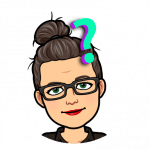 With the COVID-19 lockdown, the Digital Learning Environment (DLE) issues are relevant like never before. Teachers who have been allowed to stick to their paper programs, regurgitating content from previous classes that they’ve taught or from purchased sources and shying away from digital tools and applications, must now think on their feet to create online programs to suit their classes and individual students.
With the COVID-19 lockdown, the Digital Learning Environment (DLE) issues are relevant like never before. Teachers who have been allowed to stick to their paper programs, regurgitating content from previous classes that they’ve taught or from purchased sources and shying away from digital tools and applications, must now think on their feet to create online programs to suit their classes and individual students.
The Digital Education Advisory Group, approximately 8 years ago, wrote: “What is now required is a catalyst intervention to bring into recognisable focus the change that the whole community will recognise and welcome as transformation that shapes our future” …”We need to harness the transformative potential of digital technology to support new approaches to innovative learning centred around the development of 21st Century Learning skills. These include creativity and innovation; critical thinking, problem solving, decision making; life-long learning; collaboration and communication; ICT literacy; consciousness of being a local and global citizen; and personal and social responsibility” (Digital Education Advisory Group – DEAG, no date).
“Assuming a world in which the welfare of the young people and the economic health of a society and the political health of a democracy are the true goals of education, I believe modern societies need to assess and evaluate what works and what doesn’t in terms of engaging students in learning. If we want to do this, if we want to discover how we can engage students as well as ourselves in the 21st century, we must move beyond skills and technologies. We must explore also the interconnected social media literacies of attention, participation, cooperation, network awareness, and critical consumption” (Rheingold, 2010 p.24; emphasis added).
“Schools need not only to prepare students to be responsible citizens, but also to prepare them with the technological and communicative skills necessary to engage civic responsibility in a digital age” (Richards, 2010, p.520).
Teacher ability:
It takes a village: I wholeheartedly subscribe to the notion presented by Hollandsworth, Dowdy, & Donovan, (2011) that educators have a duty of care for student safety and security, educational enhancement, ethical and legal behaviours and becoming an effective member of communities, in both the physical and digital environment through policy, leadership and practice.
It does, indeed, ‘take a village to raise a child’ to be a good global and digital citizen, and this process should include all stakeholders: parents, teachers, teacher librarians, administrators, academics, technology professionals and, none the least of which, students. This means that educators must be proactive in effective digital citizenship DLE (including risk awareness et al), as well as in fostering student peer mentor programs, effective student role models, and quality educational faculty/staff DLE ability.
PLC, PLN, PLE, DLE: Furthermore, we as educators need to foster professional learning communities (PLC) through culture of personal learning networks (PLN) and personal learning environments (PLE), including networks within the Digital Learning Environment (DLE) according to ‘Steve Wheeler on future learning environments: professional, powerful and personal’ (YouTube / 2:09 mins) | https://youtu.be/db9PXLqoduQ
Creation of content:
There are some great resources for creating content, as recommended by ETL523 Module 1, including:
- https://www.commonsense.org/education/
- https://globaldigitalcitizen.org/
- http://www.newmedialiteracies.org/our-space-being-a-responsible-citizen-of-the-digital-world/
Just as most schools have created a school ‘code of conduct’, so too should they proactively (rather than reactively) teach a DLE ‘code of conduct’ (Hollandsworth, et al, 2011). And just as we review and evaluate the quality of our lesson content and physical curriculum, so too should educators have a structured means in which to create, deliver and then evaluate their online DLE digital citizenship curriculum. (I like the ‘writing on the bathroom wall’ analogy, which links toilet graffiti to the banter and issues that sometimes arise in social media platforms or chats-we should have a plan for how to help students handle these situations in both environments as neither are able to be fully policed or ‘filtered’ by adults). A great source of raising awareness in students are the Pause and Think by Commonsense Education.
In terms of ways to teach digital footprint ideas to students, I particularly like the videos by Everyone – Think before you post, and the blog post by Nielsen (2011), Discover what your digital footprint says about you.
Furthermore, we need to reconsider the curriculum and how we have created and delivered content in the past: “For educators and the schools in which they teach, the challenges of this moment are significant. Our ability to learn whatever we want, whenever we want, from whomever we want is rendering the linear, age-grouped, teacher-guided curriculum less and less relevant.” (Richardson, 2008, Emphasis added).
Brown, Dehoney and Milichap (2015) surmise that the core dimensions of Next Generation Digital Learning Environment (NGDLE) are:
- Interoperability and integration
- Personalisation
- Analytics, advising and learning assessment
- Collaboration
- Accessibility and universal design
Lindsay & Davis’ (2012) ‘enlightened digital citizenship model’ recommends we consider digital citizenship in terms of four areas of content:
- Safety and privacy
- Etiquette and respect
- Learning habits – workflow
- Literacy and fluency
Social media / Digital footprints (safety / privacy / brand):
We all have a digital footprint and we must model and teach an awareness of this to students. I agree with Richards (2010) who points out that we either teach students how to engage in social media responsibly, or risk them attempting it on their own, which is very much in line with research on sexual reproduction education. Wheeler equates learning about the internet to learning how to cross the road safely – what better place to teach these concepts than in school? (Wheeler, 2015, p.176).
I think it is imperative that this education begins prior to students having a substantial digital footprint, adhering to guidelines like ‘no facebook until you are 13’ – because teaching them to be mindful of what they display digitally after they have already begun displaying themselves, is like trying to teach someone who has just voted in a political election, how to vote. We must teach them early on how our digital footprint or identity is now our (online) personal ‘brand.’
We are identified at home in one way, at work or school in one way, and online or digitally in one way and our identities change through the passage of time. People can forget or not know anything about your identity in the real world, but in the digital environment, your identity is more permanent. Furthermore, the 21st century boundaries between these contexts are now blurred. We need to ask our students and them how to recognise ‘what is your identity?’ across these three platforms and throughout time.
We must therefore consider that students (and teachers) need to be literate in (aka be able to have understanding access) social media, which requires: attention, participation (civil or otherwise), collaboration, network awareness and critical thought (or critical ‘consumption’) as according to Rheingold, H. (2010).
 Something else to consider is that we have an expectation that students will be capable of digital citizenship, when their understanding of citizenship overall is still developing, particularly at the K-6 level. We must be aware of the way that we have learnt citizenship in the face to face world and how 21st Century learners have not had the same face to face opportunities and foundations that we’ve had. They must learn citizenship face to face and digitally simultaneously…like learning two different languages at the same time! Furthermore, social networks and social media have played a significant part in changing citizenship and previous boundaries and accepted expectations for social behaviour. Some face to face social constructs (such as body language) are not relevant in the digital social environment and as a result, effective use of emoticons or gifs or memes have been created to fill the void.
Something else to consider is that we have an expectation that students will be capable of digital citizenship, when their understanding of citizenship overall is still developing, particularly at the K-6 level. We must be aware of the way that we have learnt citizenship in the face to face world and how 21st Century learners have not had the same face to face opportunities and foundations that we’ve had. They must learn citizenship face to face and digitally simultaneously…like learning two different languages at the same time! Furthermore, social networks and social media have played a significant part in changing citizenship and previous boundaries and accepted expectations for social behaviour. Some face to face social constructs (such as body language) are not relevant in the digital social environment and as a result, effective use of emoticons or gifs or memes have been created to fill the void.
Delivery of content:
In order to deliver the content or curriculum, the devices and tools chosen must be convenient, consistent, and allow for frequent access to digital devices (Mann, 1999; Kelley & Ringstaff, 2002; NCES, 1999; and Statham & Torrell, 1999, in Kemker, 2005).
Having access to physical technology (primarily due to SES) is not the only issue. As pointed out by Jenkins, Clinton, Purushotma, Robinson & Weigel (2006), teachers who wish to obtain full involvement of their students by creating a ‘participatory culture,’ must also make adjustments to their pedagogy based on:
- Individual student ability to participate in the DLE given their varied access to opportunities, experiences, skills and knowledge,
- The varied degrees of understanding media transparency (or lack thereof) around how media shape world views, or how to apply filters for the large number of ‘hits’ or ‘tweets’ or emails that one receives so as to not become overwhelmed,
- and the varied degrees of understanding, training or socialisation of digital citizenship or ethical expectations for global DLE success.
 (Note to self: The issue of access to the internet, devices, applications and digital or social media tools in terms of Socio Economic Status and individual choice was covered in ETL401 and ETL503 and in my blog posts for those courses).
(Note to self: The issue of access to the internet, devices, applications and digital or social media tools in terms of Socio Economic Status and individual choice was covered in ETL401 and ETL503 and in my blog posts for those courses).
Furthermore, we must plan whether our delivery will be synchronous or asynchronous (or a mixture of the two): “Synchronous discussion is real-time or live communication that takes place on platforms such as instant messengers, audio chat, or video chat. Asynchronous discussion is non-live communication that takes place over time and includes platforms such as e-mail, discussion forums, blogs, and wikis” (Richards, 2010, p.516).
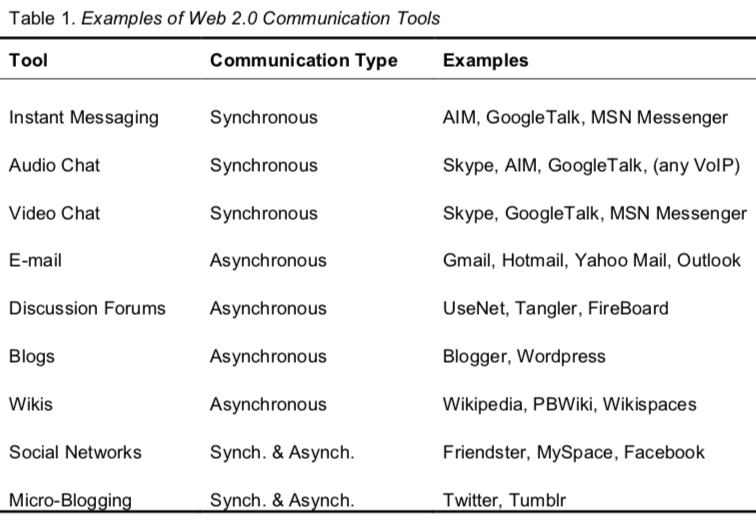
Evaluation & quality control:
Digital learning spaces need to be created in conjunction with digital citizenship awareness and incorporating essential attitudes and skills needed to be a productive (digital) learner . However, this means that digital citizenship is not just about recognising online copyright laws, or keeping students safe online. (See my previous post What is digital citizenship?).
Quality tools, lessons (either face to face or digitally) should enable students to be engaged in authentic tasks, connected to the real world, involving all partners of the learning community such as teachers, students, parents, business partners, and higher education experts (Kemeker, 2005). But, what can we use to measure student engagement and connectedness to ensure they are fully active, creative and ethical DLE participants?
Jenkins, et. al. (2006) have a comprehensive list of skills and competencies:
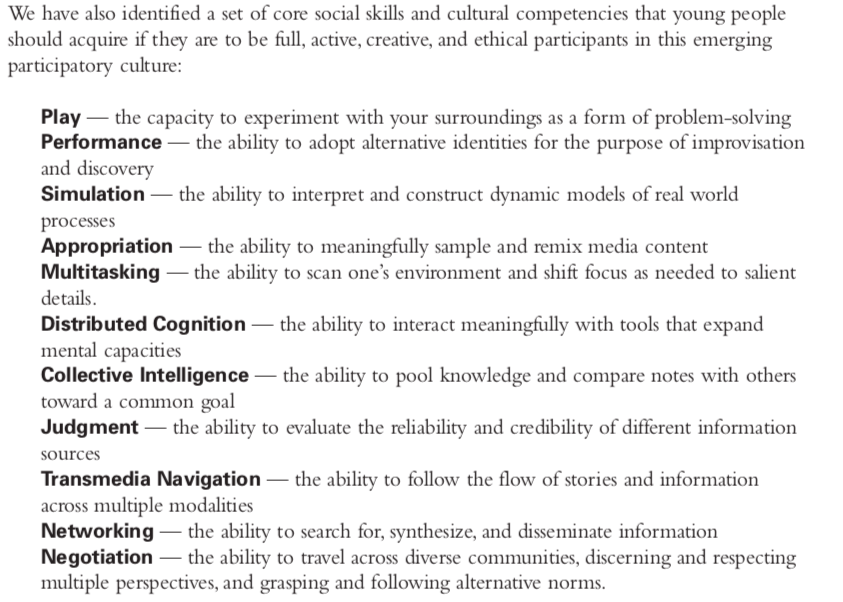
Prior to the DLE, quality standards, each with a scale of 1-5, were created by Newmann and Wehlage (1993) to help teachers assess the “authenticity” of classroom tasks and experiences, Newmann and Wehlage (1993): 1. Higher order thinking, 2. Depth of knowledge, 3. Connectedness to the world beyond the classroom, 4. Substantive conversation, and 5. Social support for student achievement – which is closely linked to the more expanded and also individually scaled from 1-5 Quality Teaching Framework (Gore, 2018):
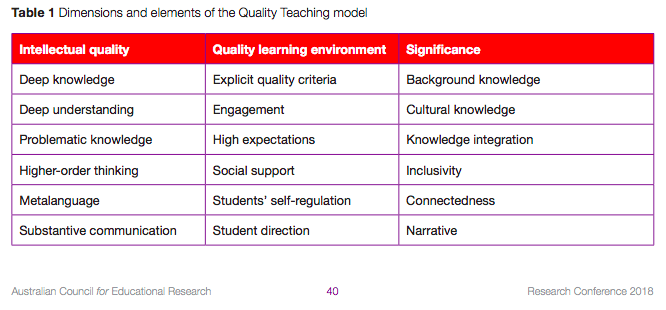
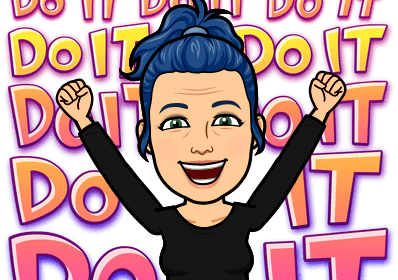
I think it is important to consider quality teaching and leadership standards within the context of the DLE, as well as the skills and competencies from Jenkins et al (2006) and possibly the 21st Century Learning skills identified from various sources (see previous blogs via tags).
References
Brown, M., Dehoney, J., & Millichap, N. (2015). The next generation digital learning environment. A Report on Research. ELI Paper. Louisville, CO: Educause April.
Digital Education Advisory Group. Beyond the classroom: A new digital education for Australian’s in the 21st Century. Retrieved from https://docs.education.gov.au/system/files/doc/other/deag_final_report.pdf
Gore, J. (2018). Dimensions and Elements of the Quality Teaching Model. [Image]. Australian Council for Educational Research – Research Conference 2018. Retrieved from https://research.acer.edu.au/cgi/viewcontent.cgi?article=1336&context=research_conference
Hollandsworth, R., Dowdy, L., & Donovan, J. (2011). Digital citizenship in K-12: It takes a village. TechTrends, 55(4) 37-47.
Jenkins, H., Clinton, K., Purushotma, R., Robison, A. J., & Weigel, M. (2006). Confronting the challenges of participatory culture: Media education for the 21st century. MacArthur Foundation website https://www.macfound.org/media/article_pdfs/JENKINS_WHITE_PAPER.PDF
Kemker, K. (2005). The digital learning environment: What the research tells us. Apple White Paper. Retrieved from (see link).
Lindsay, J., & Davis, V. (2012). Flattening classrooms, engaging minds: Move to global collaboration one step at a time. Allyn and Bacon. Chapter 5: Citizenship. (available on CSU DOMS as a downloadable PDF)
Rheingold, H. (2010). Attention and other 21st century social media literacies. Educause Review 45(5). Retrieved from http://www.educause.edu/ero/article/attention-and-other-21st-century-social-media-literacies
Nielsen, L. (2011, August 19). Discover what your digital footprint says about you. Retrieved from http://theinnovativeeducator.blogspot.com/2011/08/discover-what-your-digital-footprint.html
Richards, R. (2010). Digital citizenship and Web 2.0 tools. Journal of Online Learning and Teaching, 6(2), 516-522. Retrieved from https://pdfs.semanticscholar.org/7740/fb40e7030935d7b00d5bd07a19ba83c496ff.pdf
Richardson, W. (2008, December 3). World without walls: Learning well with others. Edutopia. Retrieved from http://www.edutopia.org/collaboration-age-technology-will-richardson.
Wheeler, S. (2015). Learning with ‘e’s: Educational theory and practice in the digital age. Crown House Pub Ltd. Chapter 12: Literacy in a connected world.
